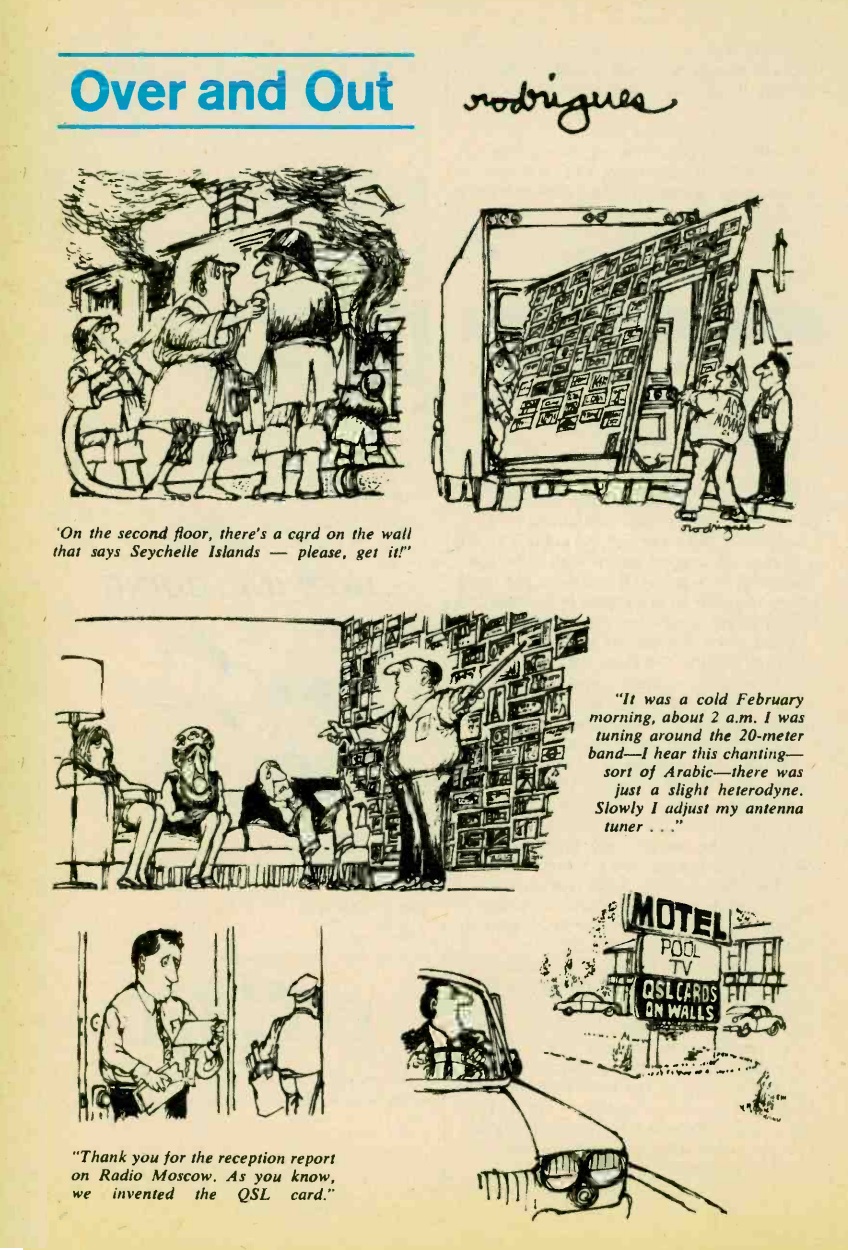 These cartoons appeared 50 years ago this month in the July 1971 issue of Electronics Illustrated.
These cartoons appeared 50 years ago this month in the July 1971 issue of Electronics Illustrated.

 These cartoons appeared 50 years ago this month in the July 1971 issue of Electronics Illustrated.
These cartoons appeared 50 years ago this month in the July 1971 issue of Electronics Illustrated.
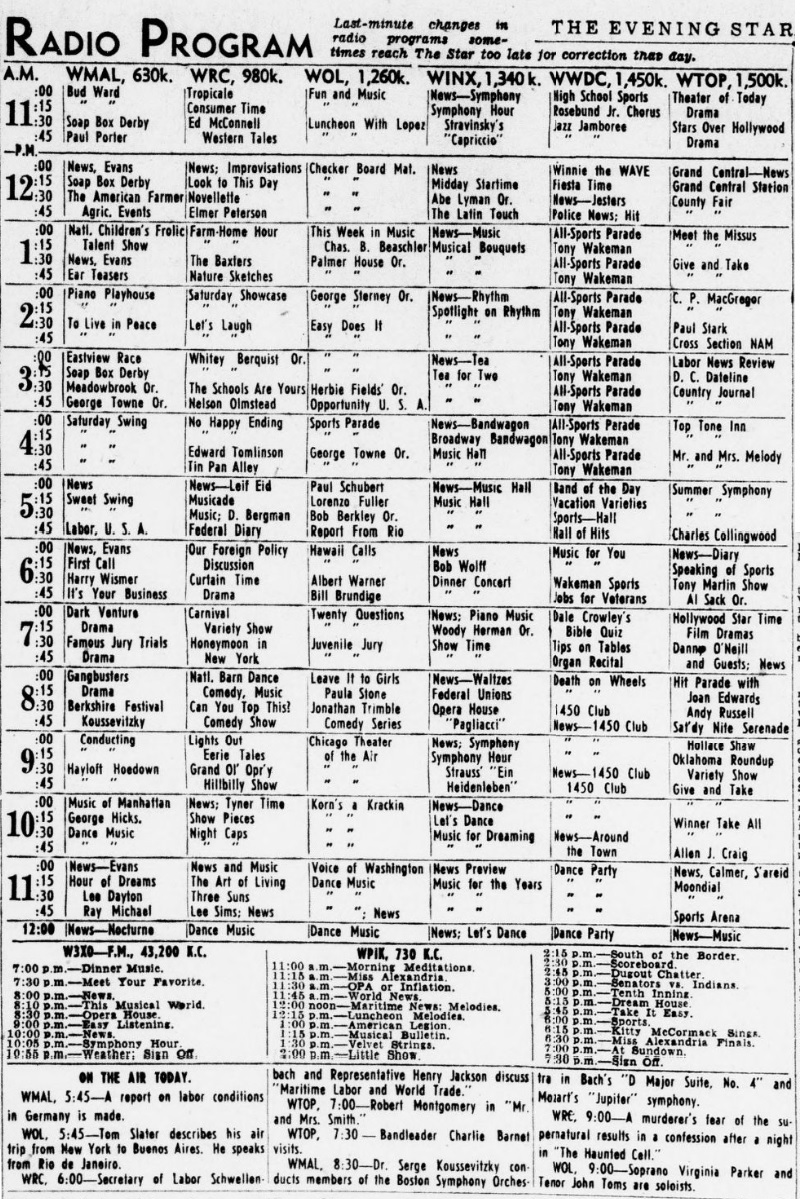 Seventy-five years ago today, here is what you would have heard on the radio in the nation’s capital. These listing are from the Washington Evening Star, Saturday, July 20, 1946.
Seventy-five years ago today, here is what you would have heard on the radio in the nation’s capital. These listing are from the Washington Evening Star, Saturday, July 20, 1946.
Click on the image to view it full size.
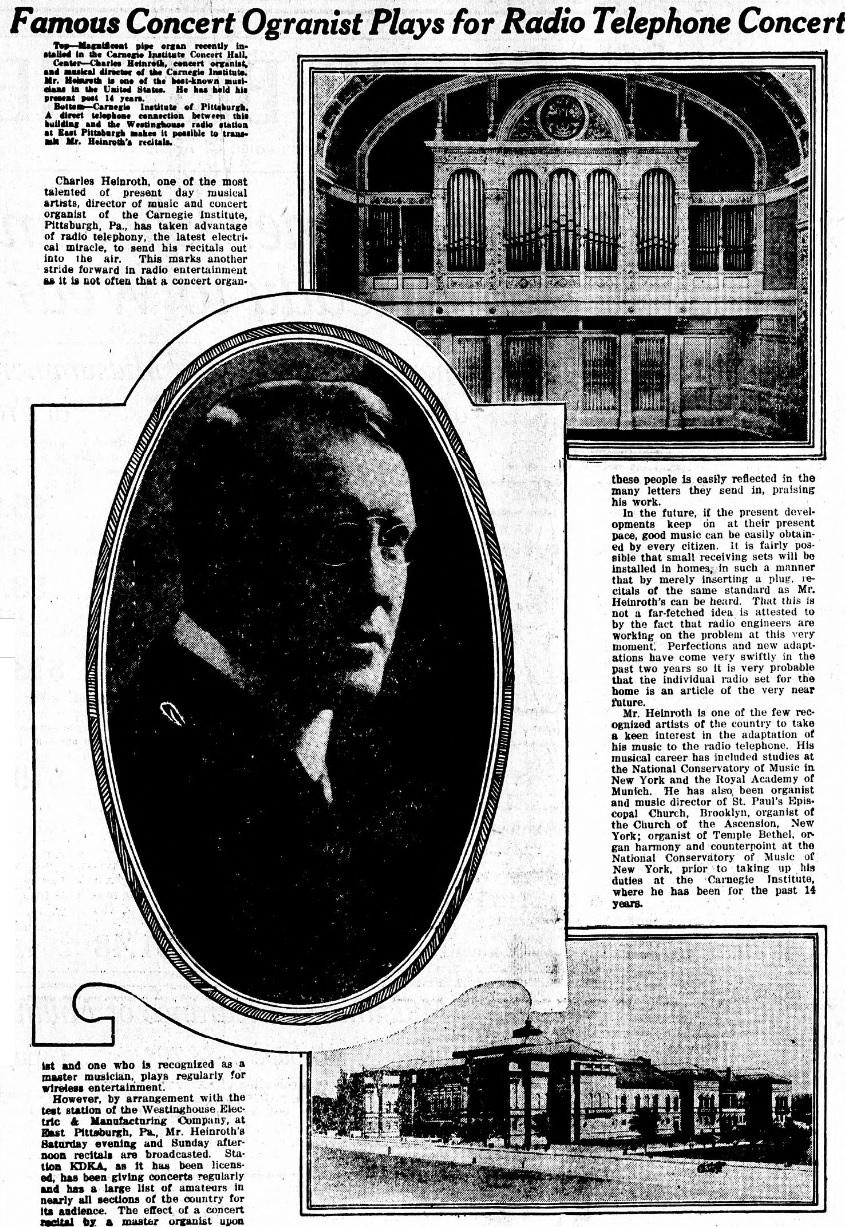 One hundred years ago today, the July 19, 1921, issue of the Bismarck (ND) Tribune
One hundred years ago today, the July 19, 1921, issue of the Bismarck (ND) Tribune
carried this article about the organ concerts being broadcast by KDKA Pittsburgh, featuring “Famous Concert Organist” Charles Heinroth.
Heinroth was the director of music and concert organist at the Carnegie Institute. His Saturday evening and Sunday afternoon recitals were carried by telephone line to KDKA across town, and then over the airwaves by the recently licensed station. The newspaper noted that the concerts were listened to by a large list of amateurs in nearly all sections of the country.
The article predicted, correctly it turns out:
In the future, if the present developments keep on at their present pace, good music can be easily obtained by every citizen. It is fairly possible that small receiving sets will be installed in homes, in such a manner that by merely inserting a plug, recitals of the same standard as Mr Heinroth’s can be heard. That this is not a far-fetched idea is attested to by the fact that radio engineers are working on the problem at this very moment. Perfections and new adaptations have come very swiftly in the past two years so it is very probable that the individual radio set for the home is an article of the very near future.
Heinroth went on to become a professor at the City College of New York in 1932, and died in 1963 at the age of 89.
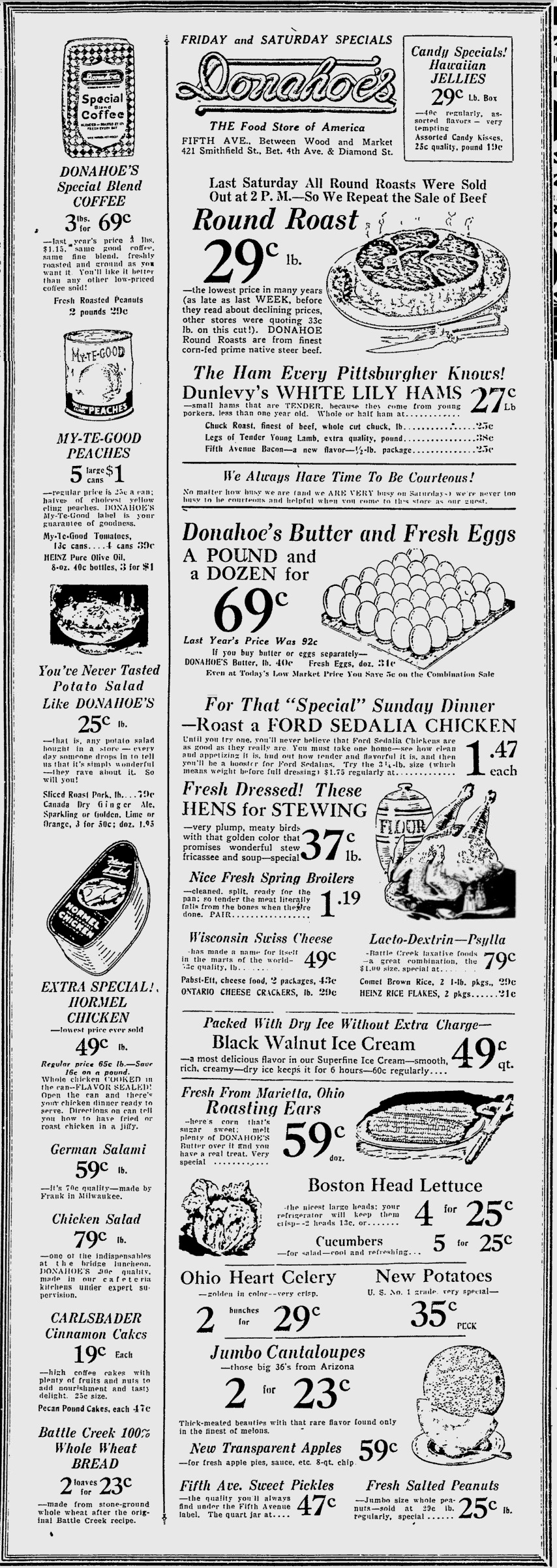 Here’s a snapshot of grocery prices in 1930, as shown in this ad for Donahoe’s food store, 421 Smithfield Street, Pittsburgh, in the July 18, 1930 issue of the Pittsburgh Press.
Here’s a snapshot of grocery prices in 1930, as shown in this ad for Donahoe’s food store, 421 Smithfield Street, Pittsburgh, in the July 18, 1930 issue of the Pittsburgh Press.
The prices look like bargains, but there’s been a lot of inflation since 1930. According to this inflation calculator, one dollar in 1930 was the equivalent of $16.12 in 2021 dollars. So you could get a pound of butter for 40 cents, but that works out to over six dollars. And a dozen eggs were 31 cents, but that’s almost five dollars today. But if you bought them both at the same time, you would only pay 69 cents, instead of the full 71 cents.
A whole chicken cost $1.19, which works out to $19 in today’s money. At least they were so tender that the meat literally fell from the bones when done.
For a treat, ice cream cost 49 cents a quart, or about $8 today. But most people didn’t have a refrigerator at home, much less one with a freezer compartment. That wasn’t a problem, since it came packed in dry ice which would keep it for up to six hours.
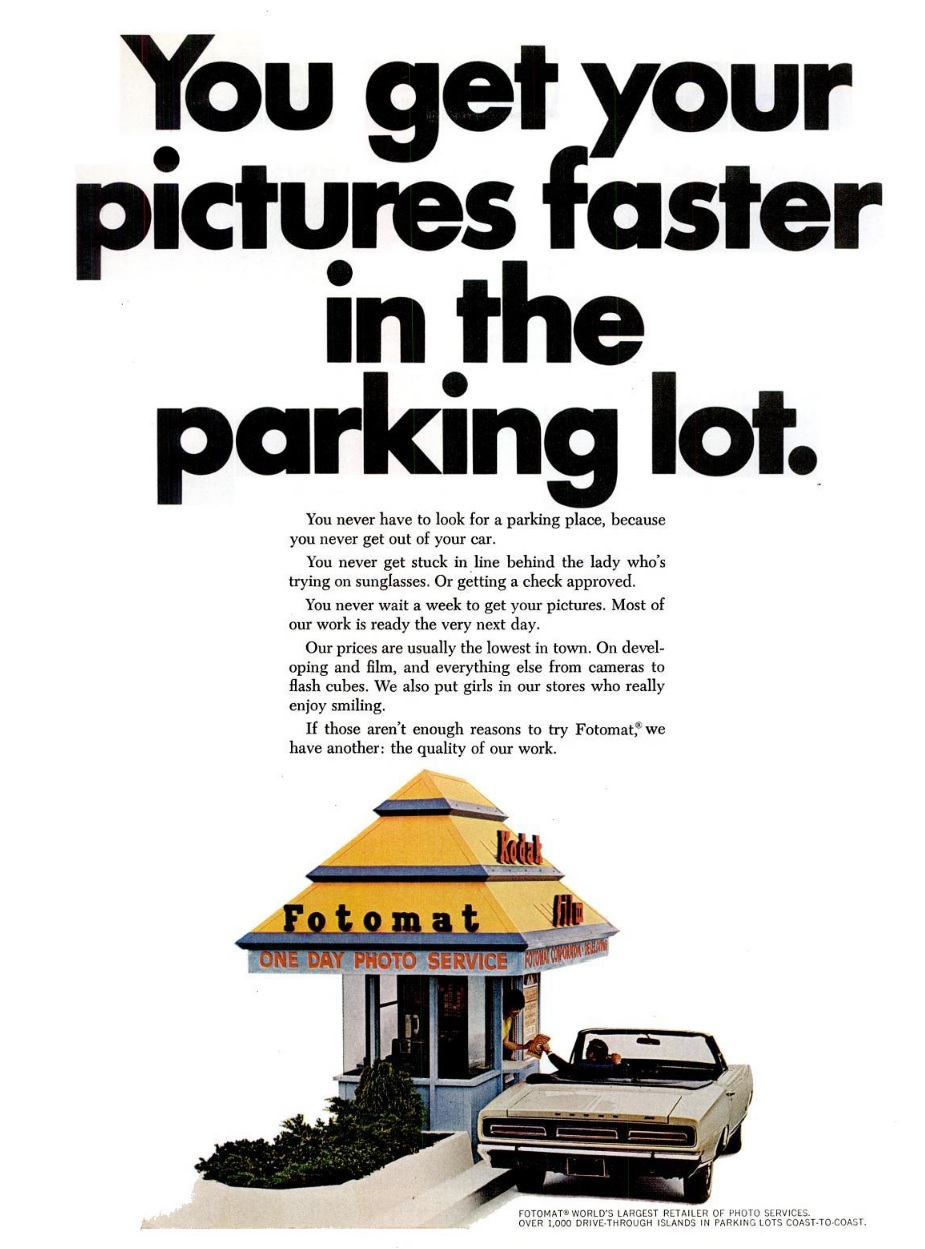 Fifty years ago today, the July 16 1971 issue of Life magazine carried this ad showing one of the most iconic structures of the 1970s, namely, the Fotomat. According to the ad, there were 1000 such structures in parking lots coast to coast.
Fifty years ago today, the July 16 1971 issue of Life magazine carried this ad showing one of the most iconic structures of the 1970s, namely, the Fotomat. According to the ad, there were 1000 such structures in parking lots coast to coast.
The first one appeared in California in 1965, the company went public in 1971, was listed on the New York Stock Exchange in 1977, and peaked at over 4000 Fotomats in about 1980.
For our readers who are too young to remember, there was a time when photography required a commodity called “film” that went inside the camera. When the film was exposed to light, a latent image would form on the film. When the film was used up, it had to be removed from the camera in complete darkness, and taken somewhere to be “developed”. This process would turn the film into a “negative,” with a visible image but with the colors reversed. The negative would then essentially be photographed a second time, and turned into a “print.”
A whole industry developed around this process. Stores sold film, and many of them allowed you to drop off the film to be developed. Typically, the film was sent by the store to a distant laboratory, and you came back a few days later to pick up your prints. It wasn’t until the end of this agonizing wait that you found out whether your pictures turned out OK. You typically paid for the developing when you picked up the pictures. They would charge you to develop the roll of film, but if some of the pictures were hopeless, they wouldn’t bother making prints of those, and you would only have to pay for the ones that they printed.
There were two solutions to this agonizing delay. The first was the development of the Polaroid camera, sometimes called the Land camera in honor of its inventor, Edwin Land. (As a youngster, I mistakenly assumed that Land cameras were for use on land, and other instant cameras were better suited for use on the water.) These cameras, through a seemingly magical process, allowed you to get the finished picture after a wait of only a minute or two. We previously featured one of their early models. The Polaroid cameras and their film were, however, expensive, and the image quality was not as good as even an inexpensive traditional camera.
American business, therefore, came to the rescue, and speeded up the developing process as much as possible. The film still needed to be sent to a large lab for developing, but Fotomat was a pioneer in expediting this process as much as possible: You dropped off the film at their little building in the parking lot, without having to get out of your car. The film was sent to their lab the same day, developed overnight, and you could pick it up the very next day, again, without having to get out of your car. You could also buy film from them, as well as other photographic accessories such as flash cubes, and even low-end cameras.
The first existential threat to Fotomat came in the 1980s with the introduction of the minilab. A minilab was a self-contained photo processing system that was small enough to put inside a retail store. No longer was it necessary to send film to a distant lab. The whole process could be done right in the store by someone with only minimal training, and it could be done while the customer waited. Fotomat allowed you to do the whole transaction without getting out of your car, but you still had to come back the next day. With the minilab, you would have to walk into the store, but you could get your pictures minutes later. Even though Fotomat “put girls in our stores who really enjoy smiling,” the chain could not compete with the faster service now offered inside a traditional store.
Of course, the final death blow to Fotomat was the digital camera, which no longer requires film or developing.
Since there were thousands of these Fotomats in supermarket parking lots around the country, many are still standing. Many of them were converted to drive-through coffee shops, although other businesses have adopted these small structures. You can see many examples at this Flickr group. You can probably see examples right in your neighborhood. Look in the parking lot of your closest strip mall, and you’ll probably find one.
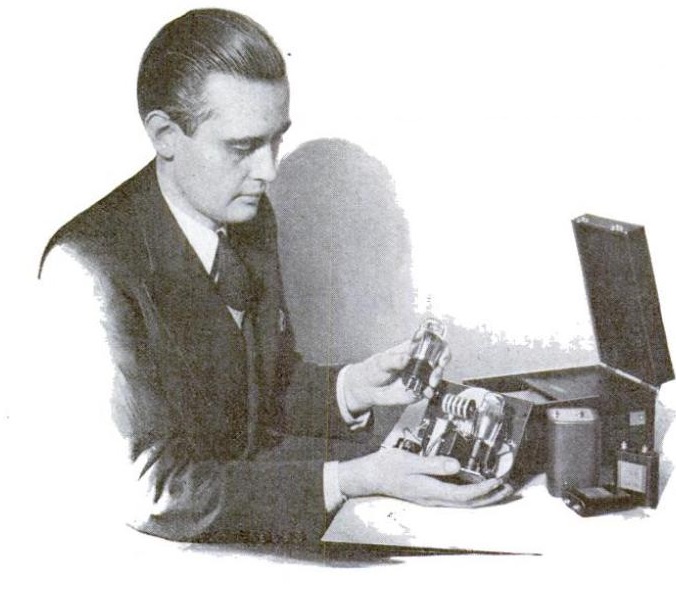
 Eighty-five years ago, this gentleman was showing off the two-tube broadcast receiver that he constructed according to the plans shown in the July 1936 issue of Popular Science. The set’s main claim to fame was that it didn’t require expensive and heavy B batteries. The two-tube regenerative set ran off of just nine volts on the plates, plus an additional 1.5 volt battery to light the filaments of the type 30 and type 40 tube.
Eighty-five years ago, this gentleman was showing off the two-tube broadcast receiver that he constructed according to the plans shown in the July 1936 issue of Popular Science. The set’s main claim to fame was that it didn’t require expensive and heavy B batteries. The two-tube regenerative set ran off of just nine volts on the plates, plus an additional 1.5 volt battery to light the filaments of the type 30 and type 40 tube.
The simple circuit required only nine commercial parts–a transformer, an RF choke, two variable condensers, the tubes and sockets, and a switch. The “pancake” coils were easily wound at home.
The article noted that the layout of the circuit was quite critical, but over the course of a few months, the author pulled in more than 50 stations as far as 1500 miles away, with just a 12 foot indoor antenna and no ground.
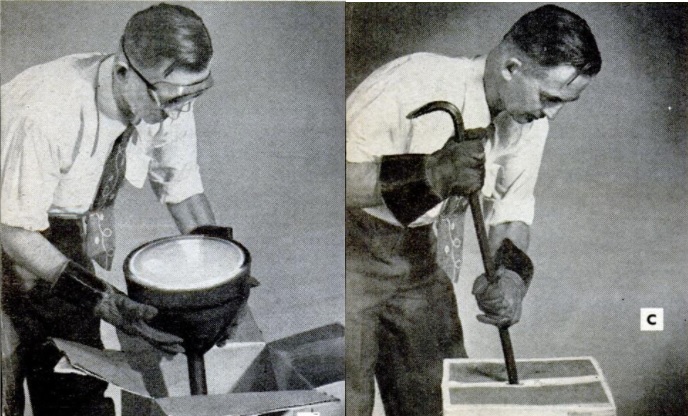 Seventy years ago this month, the July 1951 issue of Popular Mechanics gave some pointers on how to safely do some repairs to your television. The magazine noted that sets were much more complex than radios, but even inexperienced owners were often able to bring a radio set back to life by swapping tubes, and there was no reason that they couldn’t do the same thing with a television.
Seventy years ago this month, the July 1951 issue of Popular Mechanics gave some pointers on how to safely do some repairs to your television. The magazine noted that sets were much more complex than radios, but even inexperienced owners were often able to bring a radio set back to life by swapping tubes, and there was no reason that they couldn’t do the same thing with a television.
Of course, the first step was to make sure you knew which tube went in which socket, and the magazine provided sources for this information. The second issue was the high voltages, which could prove lethal, and the magazine noted how to make sure the capacitors were discharged before tackling the job.
If the picture tube had to be replaced, one important safety factor to keep in mind was that the tube could implode if dropped, sending chards of glass all over the room. As shown above, when doing this delicate job, it was important to wear gloves and safety goggles. To dispose of the old tube, it was put in the box in which the new one came. Then, it was taken to the back yard, and a crowbar was used to smash it to smithereens inside the box, so it didn’t risk implosion when the garbage man hauled it away.
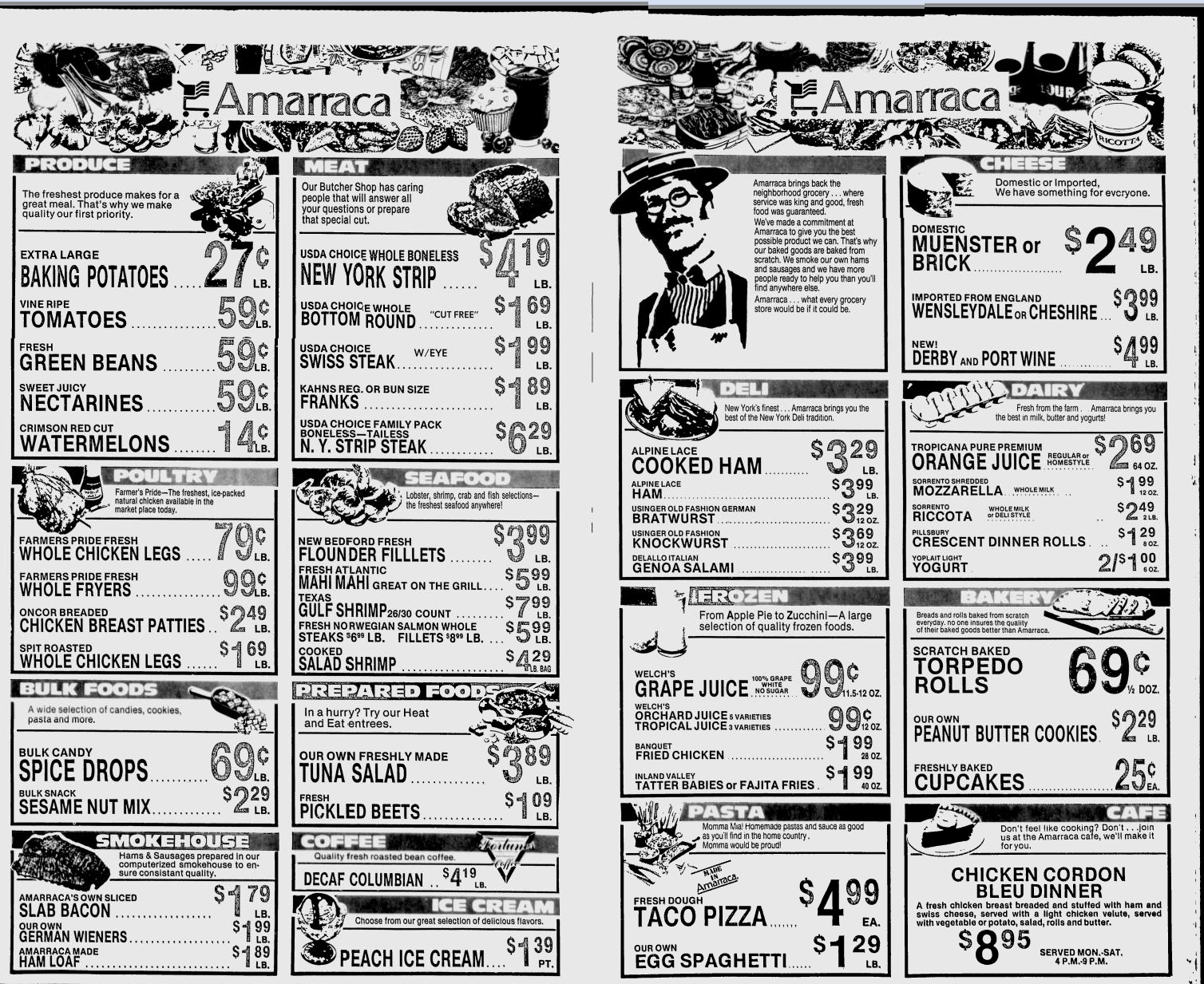 Here’s a snapshot of grocery prices in 1990, from the July 13, 1990, edition of the Pittsburgh Press. You can click on the image to view a larger version.
Here’s a snapshot of grocery prices in 1990, from the July 13, 1990, edition of the Pittsburgh Press. You can click on the image to view a larger version.
According to this online inflation calculator, the dollar was worth just over two times as much then. One dollar in 1990 is the equivalent of $2.06 in 2021 dollars.
Let’s see how some of these prices compare. We’ve taken other looks at historical prices, but since these are “only” 30 years old, we can make apples-to-apples comparisons, since many of the same brand names are still around.
Here are some examples. We show the 1990 price, and the 2021 price at a local supermarket. If you want to take a look at the modern product, the links below are to Amazon.
| Product | 1990 Price | 2021 Price | Increase x |
| Baking potatoes, per pound | 0.27 | 1.19 | 4.41 |
| Vine ripe tomatoes, per pound | 0.59 | 1.99 | 3.37 |
| Watermelon, per pound | 0.14 | 3.49 | 24.93 |
| Whole chicken, per pound | 0.79 | 1.99 | 2.52 |
| New York Strip steak, per pound | 4.19 | 20.62 | 4.92 |
| frozen grape juice, 12 oz. | 0.99 | 1.73 | 1.75 |
| Yoplait Light Yogurt, 6 oz | 0.50 | 0.67 | 1.34 |
| Tropicana Orange Juice, 64 oz. | 2.69 | 4.91 | 1.83 |
| Muenster cheese, per pound | 2.49 | 13.38 | 5.37 |
| Banquet fried chicken, 28 oz. | 1.99 | 8.44 | 4.24 |
In fairness, the 1990 prices were sale prices. And some items, like the watermelon, might have been in season that day. And you could probably shop around and find lower 2021 prices. But the official inflation rate would see all of the old prices multiplied by 2.06. So a few prices went down. And in most of our earlier price comparisons, the prices went down. But I would say that in the last 31 years, the real inflation rate has been more than the “official” rate.
Some links on this site are affiliate links, meaning this site earns a small commission if you make a purchase after clicking on the link.
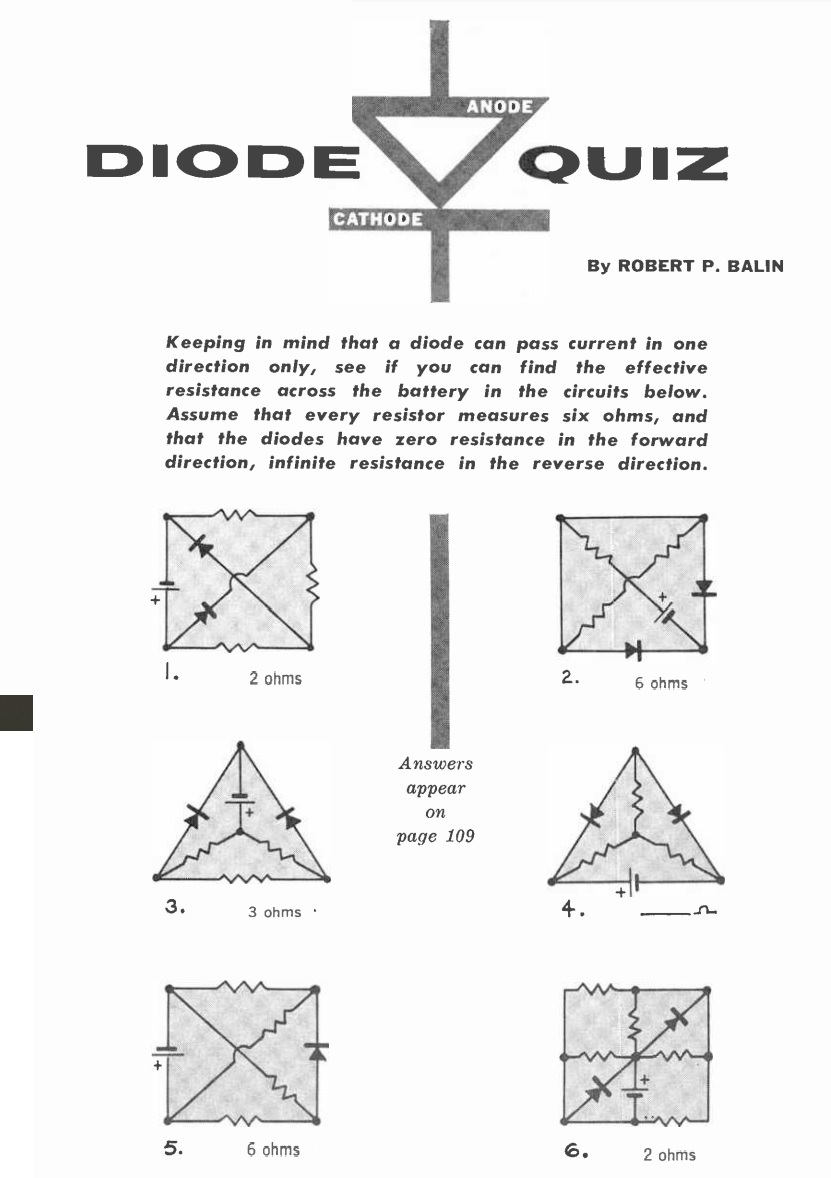 As promised, here are the answers to yesterday’s quiz, from the July 1961 issue of Popular Electronics.
As promised, here are the answers to yesterday’s quiz, from the July 1961 issue of Popular Electronics.
Today’s quiz comes from the July 1961 issue of Popular Electronics. It’s tougher than it appears at first glance. The answers will appear tomorrow.